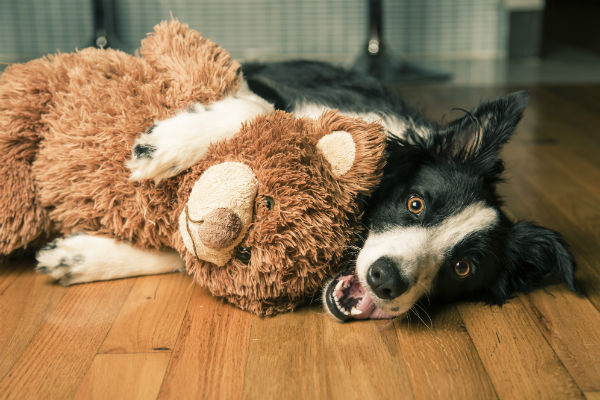Why Does My Dog Hoard?
Hoarding behavior in dogs is an instinctive behavior that originated during the time when their ancestors did not have regular meals appear magically, at least twice a day. They were lucky if they ate every few days, and if there was a jackpot of more food than could be eaten at once, these dog ancestors would sometimes take some food and bury it in a safe place for later. Wild animals do the same thing today.
You might find your dog’s toys stuffed between sofa cushions, tucked into full laundry baskets, or buried outside in the yard. It isn’t usually a problem. In fact, most people think it’s cute! But if it reaches a point where the dog can’t seem to think of anything else, pick up all but one or two toys. Do not allow toys to accumulate, scattered all over the house. Limit the space to which your dog has access. When a dog’s space is smaller, he is less likely to obsess about running around gathering up things. Give him a nice chew toy to enjoy in the crate for a while if he continues to search for more toys to gather and hide.
If the behavior leads to resource guarding (the dog getting aggressive about not letting anyone near the toys or other objects), then it becomes a matter of safety for dog and owner. Begin by making sure all toys and any items the dog might want are kept out of reach. This can seem impossible, but it’s crucial for success. Keeping things picked up around the house is a lifestyle change, and it’s understandably difficult for families. An achievable goal is to keep one room dog-safe and not to allow the dog in other parts of the house. Sometimes dogs will forget about things if the opportunity for theft is eliminated for at least a few weeks.

Even with the new tidier lifestyle in place, there still may be an occasional slipup. If the dog grabs a dropped tissue or piece of paper, just let it go! It won’t hurt anything if a dog consumes a tissue or a bit of paper once in a while. Don’t let the dog think this is worth anything to you. On the other hand, if it is your winning lottery ticket, then calmly and cheerfully head to the refrigerator for a very high-value treat and make a trade. Teach “trade” so the dog will know that something very good is coming.
Start by trading a treat for your dog’s toy. While playing with your dog, offer a tasty goody, and when the toy is released, reward! Practice this often, so that when it’s truly important, you know it will work. For more ideas on how to deal with this problem, read more about resource guarding.
Occasionally, dogs can be serious resource guarders, and professional help is needed to change the behavior. If the dog is growling, snapping, or lunging when people or other pets get near his hoarded toys, then lure the dog away with a treat, put him in a crate or fenced area, and then put the toys away so the dog cannot access them. Ask your veterinarian to help you find a certified behaviorist for an evaluation.
Our dogs are cherished members of our families, sharing our lives and providing unconditional love. But all dog owners know that our canine partners have different perspectives on life than our human family members.
If you have ever asked “Why does my dog do that?” then this feature is for you. The AKC GoodDog! Helpline training team will answer your questions on dogs’ behavior and offer training advice to help you and your dog have the best relationship possible. The AKC GoodDog! Helpline is a seven-day-a-week telephone support service staffed by professional dog trainers. For more information on the service and how to enroll go to www.akcgooddoghelpline.org.


